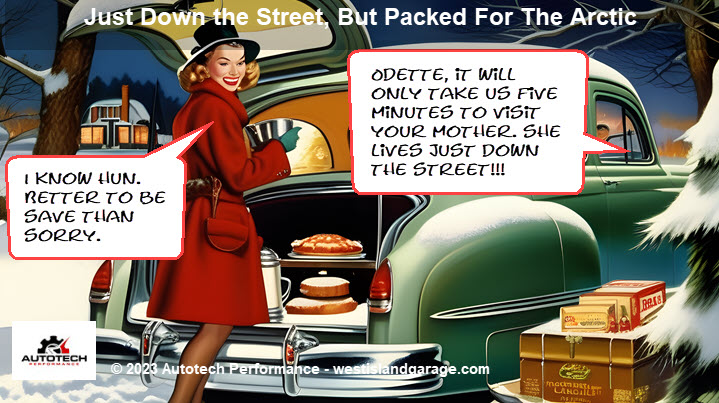
(pour français, cliquez ici) Quebec Winter Car Survival Kit – As the mercury dips and the landscape transforms into a picturesque blanket of white, the allure of Quebec’s winter wonderland is undeniable. Yet, beneath the serene beauty lies a formidable challenge for motorists: the treacherous winter roads. Each year, the season’s icy grip turns ordinary commutes into potential adventures — or misadventures. The key to mastering these frosty conditions isn’t just skilled driving; it’s preparedness.
In this essential guide, we delve into the must-have components of a winter car survival kit tailored for the unique demands of Quebec’s highways and byways. From the unexpected car breakdown to the sudden snow squall, we equip you with practical tips and lifesaving advice to ensure your winter journey is safe and secure. Whether you’re a seasoned local or a visitor braving the cold, this article is your beacon through the blizzard, illuminating the path to conquering Quebec’s winter roads with confidence. To download and print your list of items for your Winter Car Survival Kit, please scroll to the bottom of this page.
Join us as we explore the essentials for your vehicle’s emergency kit and share survival strategies that go beyond the basics. Let’s ensure your winter travel story is one of awe-inspiring vistas and cozy cabin retreats, not roadside woes.
Section 1. Understanding the Risks of Winter Driving in Quebec
Even with snow removal operations that are second to none globally, mastering the winter roads of Quebec remains a formidable challenge. Just to provide you with an idea of the challenge snow removal represents for the provice of Quebec, cities like Montreal alone have been known to remove hundreds of thousands of tonnes of snow each winter, and the costs for such operations can run into the tens of millions of dollars. The winter season brings with it a host of hazards that can challenge even the most experienced drivers. Understanding these risks is the first step toward ensuring your safety and the safety of your passengers.
Black Ice and Snowstorms: The Invisible Threats
One of the most insidious dangers on winter roads is black ice. This thin, transparent layer of ice can form on the pavement, often undetectable until it’s too late. It’s a common cause of skidding and accidents during the colder months. Snowstorms, on the other hand, can drastically reduce visibility and make the road surface unpredictable. Both conditions require drivers to be extra vigilant and to adjust their driving techniques accordingly.
Reduced Visibility and Longer Nighttime Hours
Winter also means fewer daylight hours, with darkness falling early in the afternoon. This reduced visibility can make it harder to spot obstacles, pedestrians, or the icy sheen on the road. Headlights and taillights become crucial, not just for seeing, but also for being seen by other drivers.
The Peril of Highway Pile-Ups and Immobilized Traffic
Perhaps one of the most daunting scenarios is the risk of a mass car pile-up, known as a carambolage, which can leave vehicles entangled and immobilized for hours. In such events, highways can become parking lots, trapping families and individuals in their cars amidst frigid temperatures. The danger of hypothermia becomes very real, especially for young children and the elderly, as the cold seeps into the stalled vehicles. Being stuck in such a situation without proper preparation can quickly turn from inconvenient to life-threatening.
In Quebec, where the beauty of winter is matched by its might, being aware of these risks and knowing how to navigate them is essential. By understanding the potential dangers of winter driving, you can better prepare for any journey and increase your chances of arriving at your destination safely.
Section 2: Building Your Winter Car Survival Kit
When the snow blankets the roads and the chill of the Quebec winter sets in, your car becomes more than just a vehicle—it’s your lifeline. A well-stocked winter car survival kit can make all the difference during an unexpected roadside emergency. Here’s what you need to pack to ensure you’re prepared for whatever Jack Frost throws your way.
Essentials for Safety and Warmth
- Emergency Food: Keep a supply of snacks that are easy to eat and don’t require preparation, such as granola bars, dried fruits, and crackers. These are especially important if you’re traveling with small children, who may need a quick energy boost and may not have the patience or ability to wait for help to arrive.
- Drinks: It’s essential to stay hydrated in cold weather, so include water bottles that won’t freeze solid (insulated containers can help). For added comfort, an insulated thermos filled with a warm beverage like herbal tea or hot chocolate can be soothing for all passengers, and it’s a great way to keep everyone’s spirits high and body temperatures stable. Warm drinks are also a quick way to warm up from the inside out, which can be particularly comforting for young children.
- Warm Clothing and Blankets: Extra layers, gloves, hats, and thermal blankets can help retain body heat in freezing temperatures.
- First-Aid Kit: Include bandages, antiseptic wipes, pain relievers, and any personal medications.
Tools for Snow and Ice
- Ice Scraper and Snow Brush: These are indispensable for clearing your windshield and ensuring visibility.
- Shovel: A compact, foldable shovel can help dig your car out of snowdrifts.
- Traction Aids: Sand, kitty litter, or traction mats can provide the necessary grip to get moving on slippery surfaces.
Mechanical Must-Haves
- Jumper Cables: A dead battery is a common winter woe; jumper cables can get you back on the road.
- Tow Strap: If you or another motorist gets stuck, a tow strap can be crucial for a quick rescue.
- Flashlight and Extra Batteries: Power outages are common in winter storms; a reliable light source is essential.
Visibility and Communication
- Road Flares or Warning Triangles: These help alert other drivers to your presence and prevent further accidents.
- Portable Phone Charger: Keeping your phone charged ensures you can call for help when needed.
Comfort and Convenience
- Hot Packs: Hand and foot warmers can provide instant heat in frigid conditions.
- Insulated Thermos: Filled with a hot beverage, it can help keep your spirits up and your body warm.
Nutrition and Hydration for the Road
- Easy-to-Consume Food: Keep a supply of snacks that are easy to eat and don’t require preparation, such as granola bars, dried fruits, and crackers. These are especially important if you’re traveling with small children, who may need a quick energy boost and may not have the patience or ability to wait for help to arrive.
- Drinks: It’s essential to stay hydrated in cold weather, so include water bottles that won’t freeze solid (insulated containers can help). For added comfort, an insulated thermos filled with a warm beverage like herbal tea or hot chocolate can be soothing for all passengers, and it’s a great way to keep everyone’s spirits high and body temperatures stable. Warm drinks are also a quick way to warm up from the inside out, which can be particularly comforting for young children.
Having these items readily available can make a significant difference in maintaining energy levels and warmth until assistance arrives or conditions improve enough for you to safely continue your journey.
Additional Considerations
- Whistle: In case you need to signal for help without draining your phone battery.
- Local Maps: GPS systems can fail; having a physical map can guide you to safety if technology falters.
By assembling these items, you create a safety net that can protect you and your passengers from the unpredictable elements. Remember, the key to a good winter car survival kit is regular checks and replenishment. Before the winter season hits full swing, take the time to ensure your kit is complete and ready for the road. Your preparedness could be the difference between a minor inconvenience and a life-threatening situation.
Section 3: Winter Vehicle Maintenance Tips
The reliability of your vehicle during the harsh Quebec winter is paramount. Regular maintenance not only ensures your safety but also the longevity of your car. Here are some essential vehicle maintenance tips to help you navigate the winter roads with confidence.
Battery Health Check
- Battery: Cold weather can be brutal on your car’s battery. Have it tested to ensure it holds a charge and replace it if necessary. Keep the terminals clean from corrosion and ensure the connections are secure.
Tire Traction and Pressure
- Tires: Winter tires are a must in Quebec. They provide the necessary traction to handle snowy and icy conditions. Check the tire tread for wear and ensure they are properly inflated according to the manufacturer’s specifications. Remember that tire pressure can drop in colder temperatures.
Fluid Levels and Types
- Antifreeze: This is the lifeblood of your car’s engine in the winter. Ensure the antifreeze level is full and the mixture is appropriate for freezing temperatures.
- Windshield Washer Fluid: Use a winter formula that won’t freeze and always keep the reservoir full; you’ll use more in winter to clear away salt and grime.
Visibility and Lighting
- Lights: Check all your lights and replace any that are burnt out. Proper lighting is crucial for visibility during winter’s shorter days and frequent storms.
- Windshield Wipers: Consider installing heavy-duty winter wipers. They can handle the weight of snow and ice more effectively than regular blades.
Heating and Comfort
- Heater and Defroster: Ensure your car’s heating system and defroster are working efficiently. Being able to keep the interior warm and the windows clear is essential for comfort and safety.
Emergency Preparedness
- Emergency Kit: Keep an emergency kit in your car with items such as a blanket, extra gloves, and a flashlight. It’s also wise to have a small tool kit, jumper cables, and a tow rope.
By adhering to these maintenance tips, you can reduce the risk of breakdowns and accidents. A well-maintained vehicle is your best defense against the unpredictable nature of winter driving. Take the time before the season starts to ensure your car is as ready for winter as you are.
Section 4: Lifesaving Tips for Surviving a Breakdown
Despite your best efforts in vehicle maintenance and preparation, breakdowns can still occur. Knowing how to respond in these situations is critical, especially during the unforgiving Quebec winter. Here are some lifesaving tips to keep in mind if you find yourself stranded.
Immediate Actions Post-Breakdown
- If your car breaks down on the highway, DO NOT GET OUT OF YOUR CAR! Quebec highways are patrolled and you are safer in your car than walking on the highway. But if you absolutely have to exit the vehicle, attempt to exit through the passenger side of the car.
- Find a Safe Spot: If possible, pull over to the side of the road or into a designated safe area. Avoid stopping in traffic lanes or on blind curves where visibility is low.
- Stay Visible: Turn on your hazard lights immediately. If visibility is poor, set up warning triangles or flares at a safe distance behind your vehicle to alert other drivers.
Conserving Heat and Resources
- Stay Inside: Your vehicle offers shelter and conserves heat. Bundle up in extra clothing or blankets and huddle together for warmth if you’re not alone.
- Monitor Exhaust Pipe: Ensure it’s clear of snow to prevent carbon monoxide buildup inside the car.
- Conserve Fuel: Run the engine and heater sparingly. Use them just enough to remove the chill and to conserve fuel for a longer duration.
Signaling for Help
- Call for Assistance before exiting your car: Use your cell phone to call for help. If you have no signal and find youself on a lonely road with houses not too far away, a storm whistle can be a valuable tool to signal rescuers without draining your phone’s battery.
- Make Yourself Noticeable: If you’re in a remote area, use anything bright or reflective to make your vehicle more visible. Place colorful fabric or an emergency blanket on the antenna or hang it out a window.
Managing Food and Hydration
- Ration Supplies: If you have food and water, use them sparingly. In cold conditions, your body will need more fuel, but it’s essential to make your supplies last.
- Avoid Eating Snow: If you’re out of water, don’t eat snow as it will lower your body temperature. Instead, melt it first before drinking.
Staying Calm and Collected
- Keep a Clear Head: Panic can lead to poor decisions. Stay calm, think through your actions, and focus on keeping yourself and your passengers safe.
- Stay Put: Unless you’re sure about where you are and how far it is to get help, it’s safer to stay with your vehicle. Venturing out in a storm can put you at greater risk.
Here you go! We’ve navigated through the essentials of winter driving in Quebec, from gearing up your car with the right survival kit to keeping it in tip-top shape for those frosty roads. And if you do find yourself in a bind, now you’ve got the know-how to stay safe until help arrives.
Remember, being prepared isn’t just about peace of mind—it’s a necessity when the snow starts falling. So let’s not take any chances, and make sure we’re all set for whatever winter throws our way.
By following these tips, you can increase your chances of staying safe during a winter breakdown. Remember, preparation and calm decision-making are your best tools for survival until help arrives.
Before you head out, make sure to download your free checklist of winter storm car survival essentials. It’s right [here] for you—just one click away.
Our team of specialists at Autotech Performance, a CAA Quebec certified automotive garage are ready to answer your questions about how to get your car ready to brave the harshest of winter – simply give us a call or book an appointment online.
Enjoy safe driving!
Your Team at Autotech Garage
To download and print your list of items for your Winter Car Survival Kit, click here: Quebec Winterstorm Car Survival Kit




